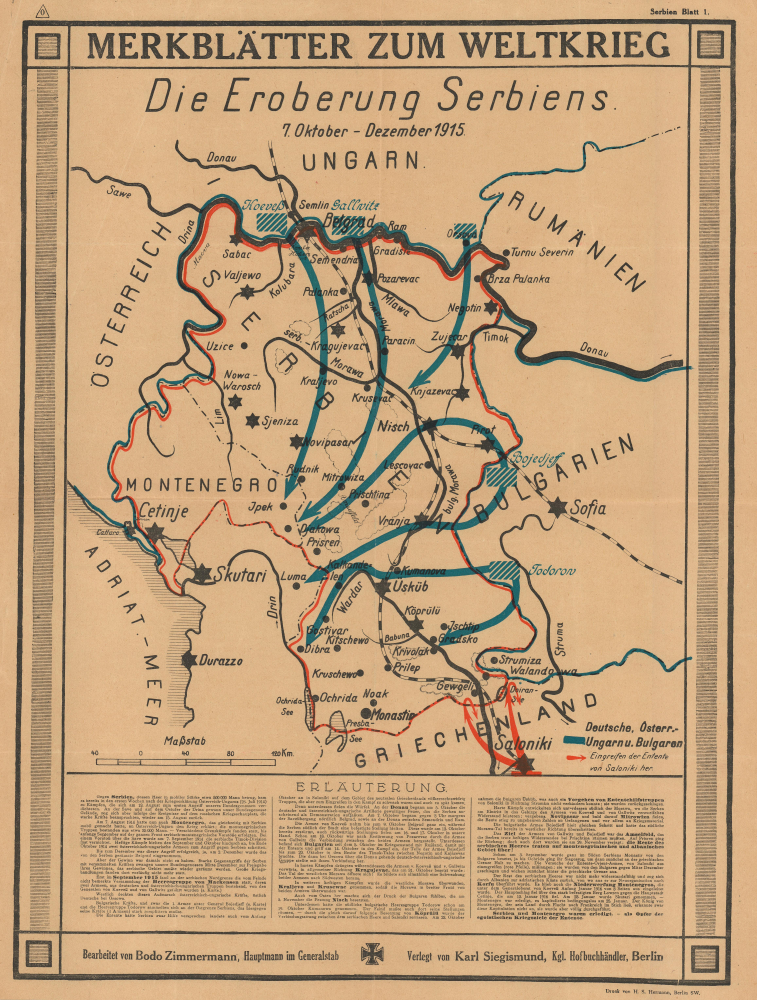Digital Image: 1916 German Propaganda Map of the WWI Central Powers Conquest of Serbia
EroberungSerbiens-zimmermann-1918_d
Title
1918 (undated) 20.5 x 14.75 in (52.07 x 37.465 cm) 1 : 1716480
Description
FOR THE ORIGINAL ANTIQUE MAP, WITH HISTORICAL ANALYSIS, CLICK HERE.
Digital Map Information
Geographicus maintains an archive of high-resolution rare map scans. We scan our maps at 300 DPI or higher, with newer images being 600 DPI, (either TIFF or JPEG, depending on when the scan was done) which is most cases in suitable for enlargement and printing.
Delivery
Once you purchase our digital scan service, you will receive a download link via email - usually within seconds. Digital orders are delivered as ZIP files, an industry standard file compression protocol that any computer should be able to unpack. Some of our files are very large, and can take some time to download. Most files are saved into your computer's 'Downloads' folder. All delivery is electronic. No physical product is shipped.
Credit and Scope of Use
You can use your digial image any way you want! Our digital images are unrestricted by copyright and can be used, modified, and published freely. The textual description that accompanies the original antique map is not included in the sale of digital images and remains protected by copyright. That said, we put significant care and effort into scanning and editing these maps, and we’d appreciate a credit when possible. Should you wish to credit us, please use the following credit line:
Courtesy of Geographicus Rare Antique Maps (https://www.geographicus.com).
How Large Can I Print?
In general, at 300 DPI, you should at least be able to double the size of the actual image, more so with our 600 DPI images. So, if the original was 10 x 12 inches, you can print at 20 x 24 inches, without quality loss. If your display requirements can accommodate some loss in image quality, you can make it even larger. That being said, no quality of scan will allow you to blow up at 10 x 12 inch map to wall size without significant quality loss. For more information, it is best consult a printer or reprographics specialist.
Refunds
If the high resolution image you ordered is unavailable, we will fully refund your purchase. Otherwise, digital images scans are a service, not a tangible product, and cannot be returned or refunded once the download link is used.
Cartographer
Bodo Zimmermann (November 26, 1886 - April 16, 1963) was a German army officer and general during World War II. Born in Metz, Germany (at the time Metz was in Germany because Alsace and Lorraine were ceded to Germany after the 1870-71 Franco-Prussian War), he left the cadet corps and joined the 145th Royal Infantry Regiment (6th Lorraine) in March 1906 as an ensign. He was promoted to first lieutenant (Oberleutnant) in January 1907 and served in this regiment from 1907 until 1914, when he was assigned to the War Academy. World War I interrupted his studies, and he was promoted to captain (Hauptmann) early in 1915. He served on the General Staff at the General Command of the III Army Corps until 1917 or 1918, when he was transferred to the War Press Office of the Supreme Army Command (OHL - Oberste Heeresleitung). He became a head of department at the War Press Office and in 1918 published 35 different broadsides on the World War (Merkblätter zum Weltkrieg). After the war, the Siegismund publishing house published nine texts written by Zimmermann, eight of which would more appropriately be qualified as propaganda brochures. Zimmermann retired from the army in 1920 and received the rank of major. He continued writing and publishing after the war and founded the military publishing house Offene Worte in 1920 in Berlin. Between 1931 and 1941, Zimmermann published five books through this publishing house. Zimmermann was reactivated into the German Army in December 1938 and was assigned to the 1st Army as First General Staff Officer. He was appointed First General Staff Officer of Army Group D in occupied France in October 1940. He was promoted to lieutenant colonel on August 1, 1941, and colonel on December 1, 1942, and was made General von Rundstedt's chief of operations. In June 1944, Zimmermann remained the Operations Officer at OB West (the command of German forces on the Western Front). On June 5, 1944, he received a message from Hans Speidel at Rommel's headquarters that the Fifteenth Army had been put on alert. Zimmermann declined to put the Seventh Army (which was defending Normandy) on alert 'because of the weather'. The next day, June 6, 1944, became etched into history when Allied forces stormed the beaches in Normandy on D-Day. He was promoted to Chief of the Command Department of OB West in the fall of 1944 and remained in that job until the end of the war. He was promoted to major general on December 1, 1944, and to lieutenant general on May 1, 1945 (eight days before the surrender). After the war, he was captured and remained a prisoner until 1947. After his release, he published a handful of books about World War II. He died in Bonn in 1963. More by this mapmaker...

